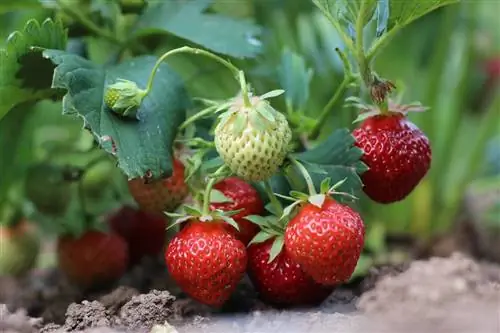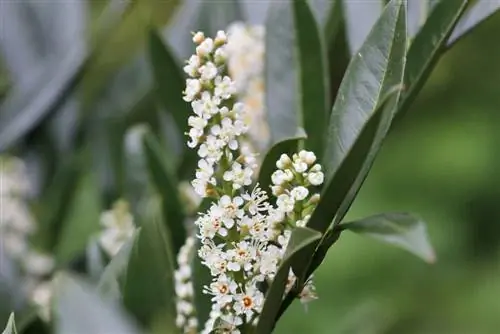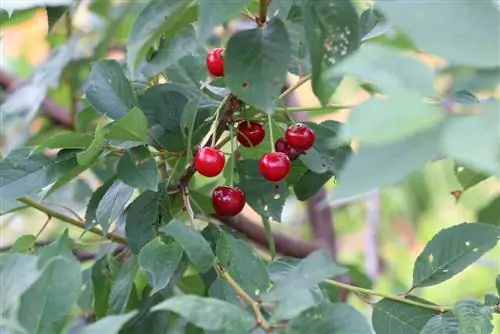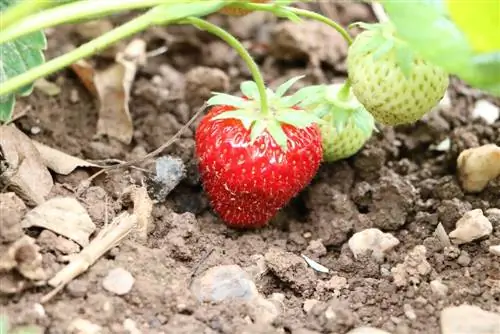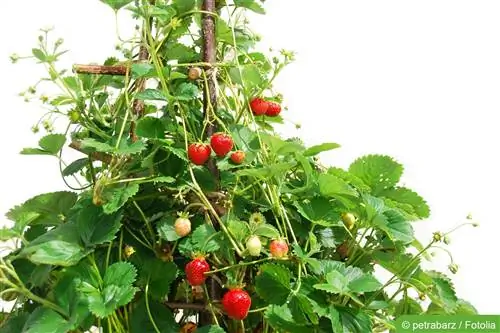- Author admin [email protected].
- Public 2023-12-17 03:39.
- Last modified 2025-01-24 12:45.
Although it takes some work to plant the strawberries, the effort will be worth it when the first delicious, tasty and sweet fruits can be harvested directly from the bush to your mouth. If you plant at the right time, you can harvest the first fruits next summer. The first plants will be available in well-stocked specialist retailers as early as July. But your own offshoots can also be used and will also be ready for harvest next year.
plants
Strawberry plants are available in many different varieties and preparations in well-stocked garden shops. The prepared plants are offered here in three forms:
- as green plants
- as frigo plants
- as potted plants
The green plants packed in waterproof plastic bags ensure that they stay fresh for a long time. Although they produce a high crop yield, they are always vulnerable to drought. The Frigo plants, on the other hand, are strawberry varieties that are harvested in the winter months. They are available in garden shops until July and are generally planted by commercial farmers in order to extend the harvest. The potted plants, on the other hand, are delivered with root balls and have been grown in a peat-soil substrate. These are relatively expensive in comparison, but also produce a high crop yield. When buying strawberry plants, you should especially make sure that they have a strong heart bud in the middle and at least three he althy leaves. You should also take a look at the roots in advance.
Tip:
If green plants are purchased, they should be removed from the plastic bags until they are planted so that they receive air. Otherwise it could be damaged in the moisture,
Planting time
The planting time varies and depends on the different strawberry varieties. However, the hobby gardener should remember two important times for planting. The plants, which bear fruit several times a year, are planted in late summer, in August of the previous year, and then offer a lush harvest over the entire summer the following year. However, if this planting date was not met, then it makes more sense to plant the plants in spring in April; these can also be harvested in the same year, but the yield will be lower.
Tip:
The plants should not be planted later than August or early September because they still need a lot of sun to grow well before winter. Plants that are planted too late in the bed can rot at the roots.
Soil preparation
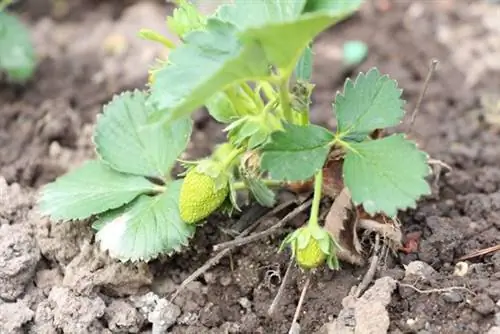
Before planting, the soil must be prepared, especially in the garden bed. Since strawberry plants should be planted in a different location each year based on the soil in order to provide rich yields, a bed can be used that has already been used and harvested from another previous crop. Legumes or early potatoes, for example, are ideal here. The bed intended for this purpose should be prepared at least 14 days before planting the strawberries so that the soil can settle sufficiently before planting. The preparation proceeds as follows:
- Dig up earth
- create a drainage on the bottom of the hole
- use stones or potsherds for this
- lay these flat on the bottom
- the soil should be slightly acidic between pH 5.5 and 6.5
- mix compost into the garden soil
- peat or stable manure are also suitable
- put the mixed substrate back into the bed via the drainage
Tip:
Humus fertilizer, which is available in packaged form from well-stocked garden shops, can also be used to mix into the garden soil.
Planting spacing
The distance between the individual strawberry plants is important so that they thrive in the garden bed, raised bed or balcony box and bear lots of fruit. The resulting air circulation also ensures that the leaves can dry more quickly after a rain shower. As a rule, a distance of 40 cm is left between individual rows and a distance of 25 cm between individual plants. This means that the fruits can be easily harvested later and you can easily step between the individual rows.
Plants in the garden bed
If the prepared soil has settled after about two weeks, it must be raked smooth. Then the holes are dug for the strawberry plants. The distance provided for this should be maintained. It is helpful to pull a string from one end of the bed to the other for each row, then they will be straight. Because when digging the holes, it can be easy to lose track, depending on the size of the garden bed. The individual holes should be dug so deep that the heart of the strawberry plants is not covered with soil but lies directly above it. The roots or root ball must be completely covered with soil. Please also pay attention to the following:
- water the plants well before placing them in the ground
- to do this, put it in a bucket of water
- wait for air bubbles to stop rising
- this applies to all varieties and shapes
- the holes must be deep enough that the roots can be inserted without being compressed
- For bare-root plants, place the roots vertically and well spread out in the soil
- the roots must not be bent
- Fill the hole all around with soil
- press well and pour well
Tip:
During the first 10 to 14 days after planting, the time of growth, the plants must not dry out and should therefore be watered well in the morning and evening.
Plants in raised beds
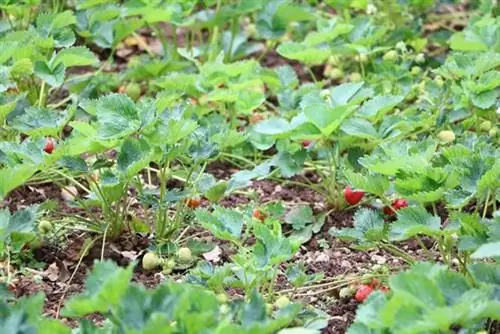
The raised bed is a good alternative to the garden bed, because strawberries and especially the fruits are very popular with snails. A raised bed can prevent annoying parasites from getting to the tasty fruits and thus destroying part of the harvest. In addition, since the soil can be replaced and re-created every year, the raised bed can be used for years. If you only want strawberries for home use, you can cultivate them in a raised bed. There is no need to pay attention to row spacing, as no space is required for harvesting. The only important thing is that the strawberry plants are spaced about 25 cm apart.
Tip:
If you only want to plant a few strawberry plants, you would be well advised to use a raised bed, because in addition to being a barrier for the voracious snails, such a higher bed is also very easy on your back during harvest.
Plants in pots
If you don't have a garden available and still like to have strawberries from your own harvest, you can also cultivate the plants in a bucket, a hanging basket or a balcony box. Depending on their length, several plants can be placed next to each other in a balcony box. The size of the pot also depends on how many strawberry plants can be cultivated here. However, the hanging baskets usually only offer space for a single plant. When cultivating in pots or balcony boxes, proceed as follows:
- create drainage over the drain hole to prevent waterlogging
- use pottery shards or pebbles for this
- put a plant fleece over it
- enter a part of the world
- Dip roots of strawberry plants in water
- insert carefully, no roots should be bent
- Carefully fill in the remaining soil and press it down
- pour well
- After half an hour, drain excess water from the plate
After planting
It is especially important to prepare the soil as follows after planting:
- Remove weeds regularly
- to store moisture, add mulch
- Mulch also keeps weeds away
- remove the mulch before fruits develop in early summer
- to keep the fruits clean, spread straw on the ground
Tip:
If clean straw is spread on the ground before the fruits form, this will also deter the snails, which like to feed on the red, delicious fruits and reduce the harvest through these feeding points.
Use offshoots
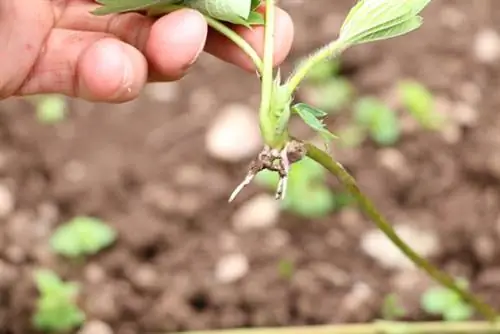
The offshoots that are formed by most mother plants in summer can be used very well from existing strawberry plants in the garden or raised bed. However, it should be noted how many years offshoots from the first mother plant have been used. Unfortunately, after a few years the yields decrease and new strawberry plants should be purchased from retailers. But in the first and second year, the cuttings can be used to cultivate the tasty fruits next year. The cuttings are obtained as described:
- dig small pots around the mother plant
- The offshoots are placed here
- these are not removed from the mother plant
- they remain connected for now
- Fill pots with fresh soil
- pour well
The second way to get the offshoots is to carefully cut them off the mother plant with a spade and then replant them in the garden bed. However, it is better to use a bucket with fresh soil.
Tip:
If the cuttings are planted back into the soil already used for strawberry cultivation in the raised bed or garden bed, this is not an advantage for the guaranteed harvest next year.


